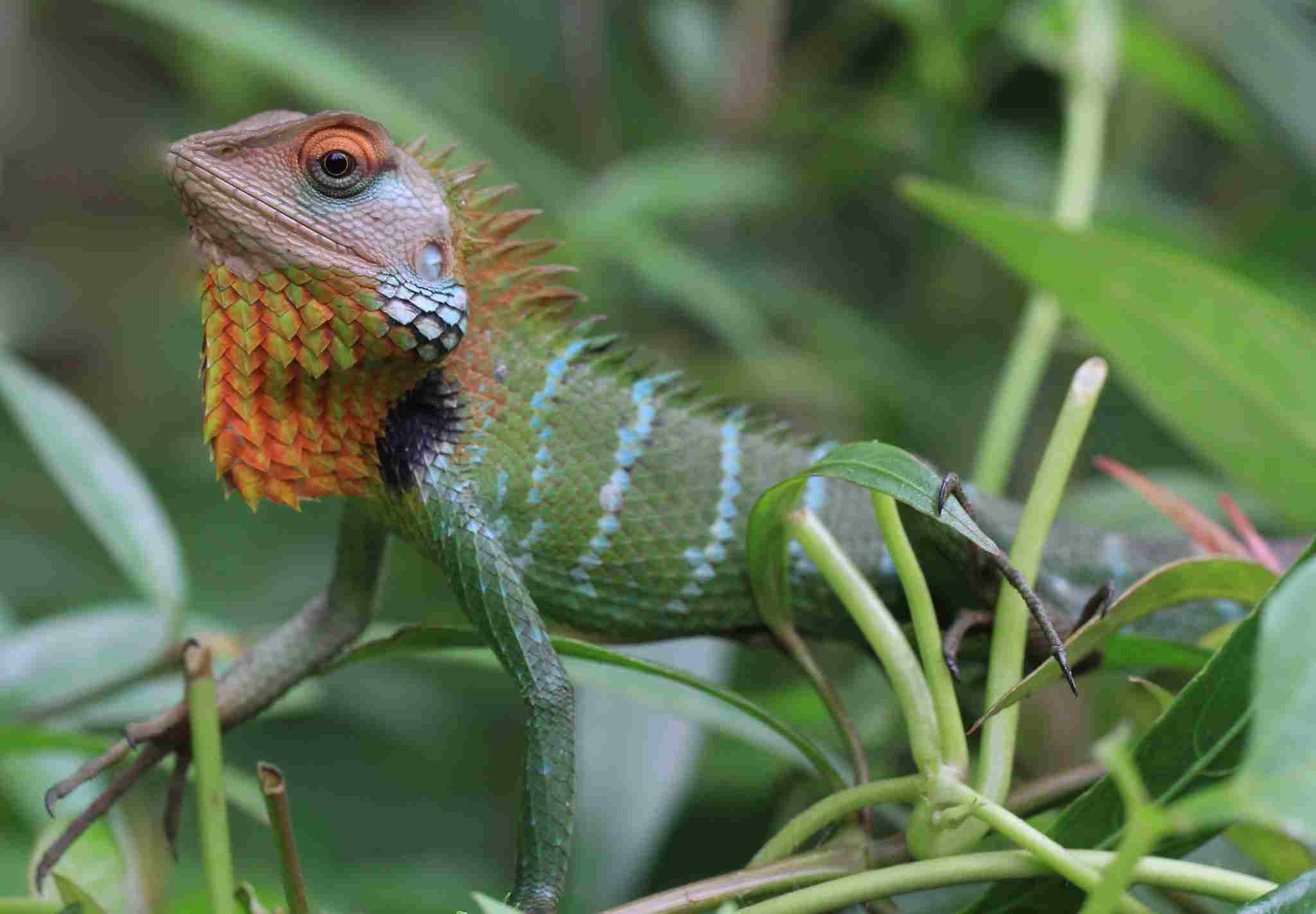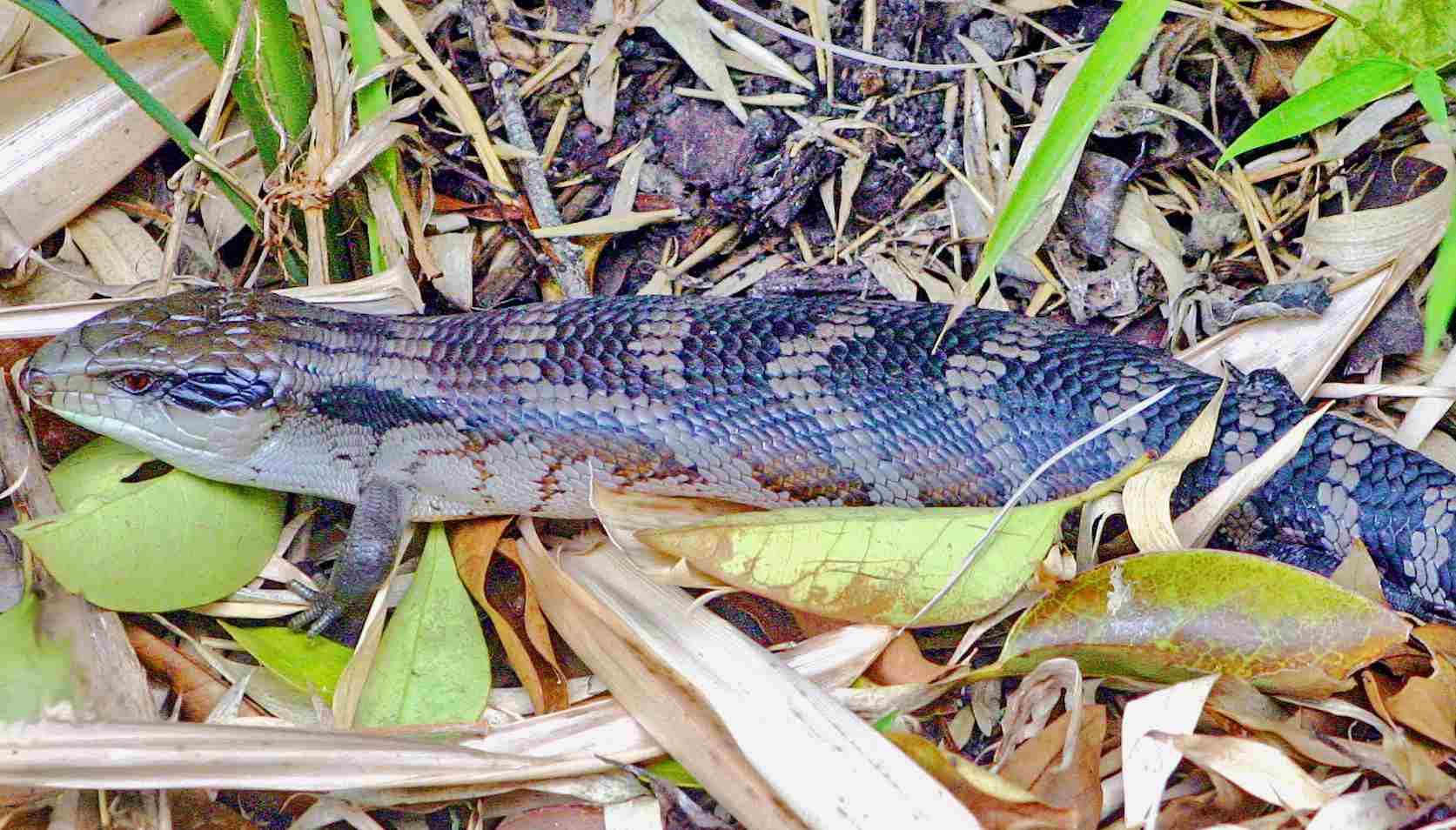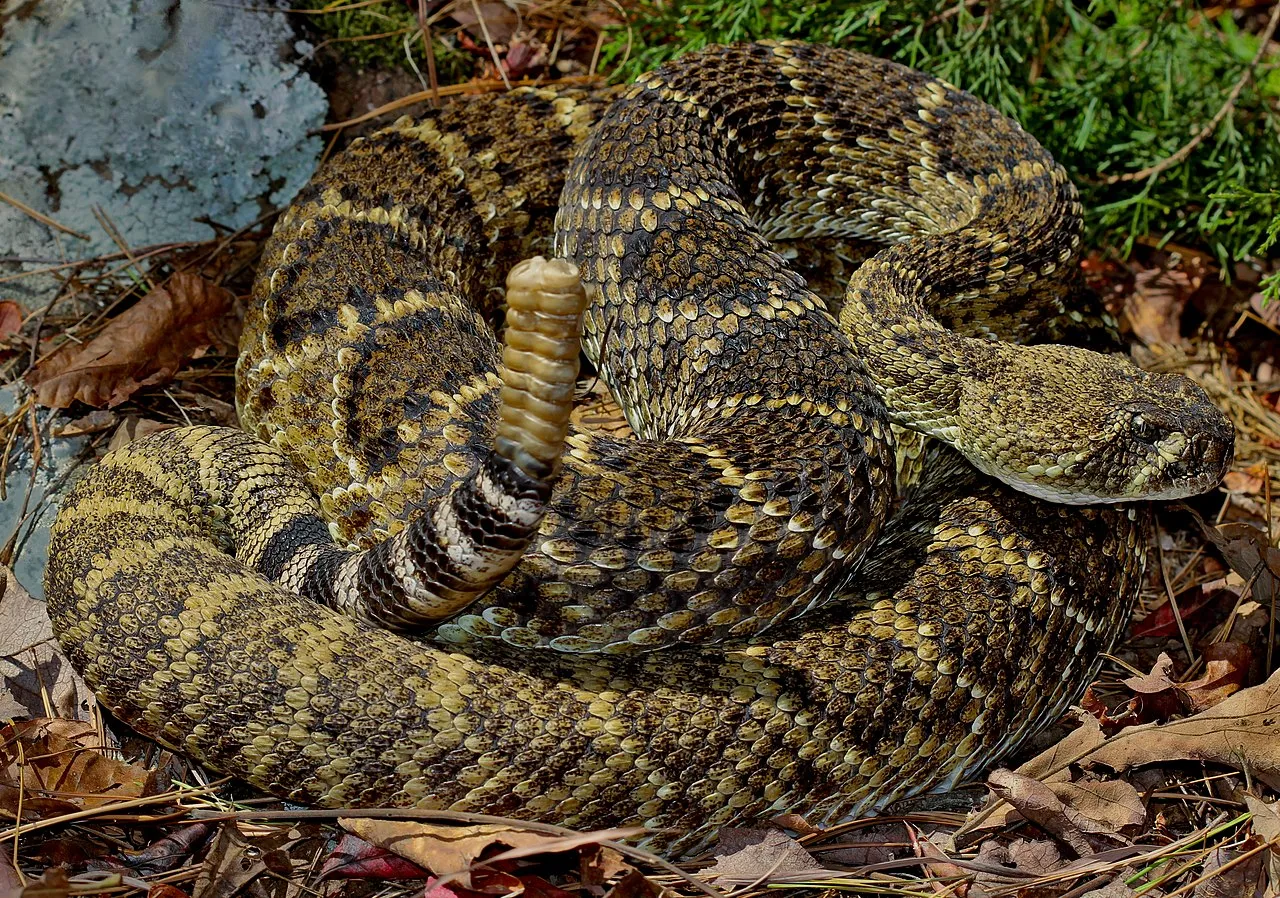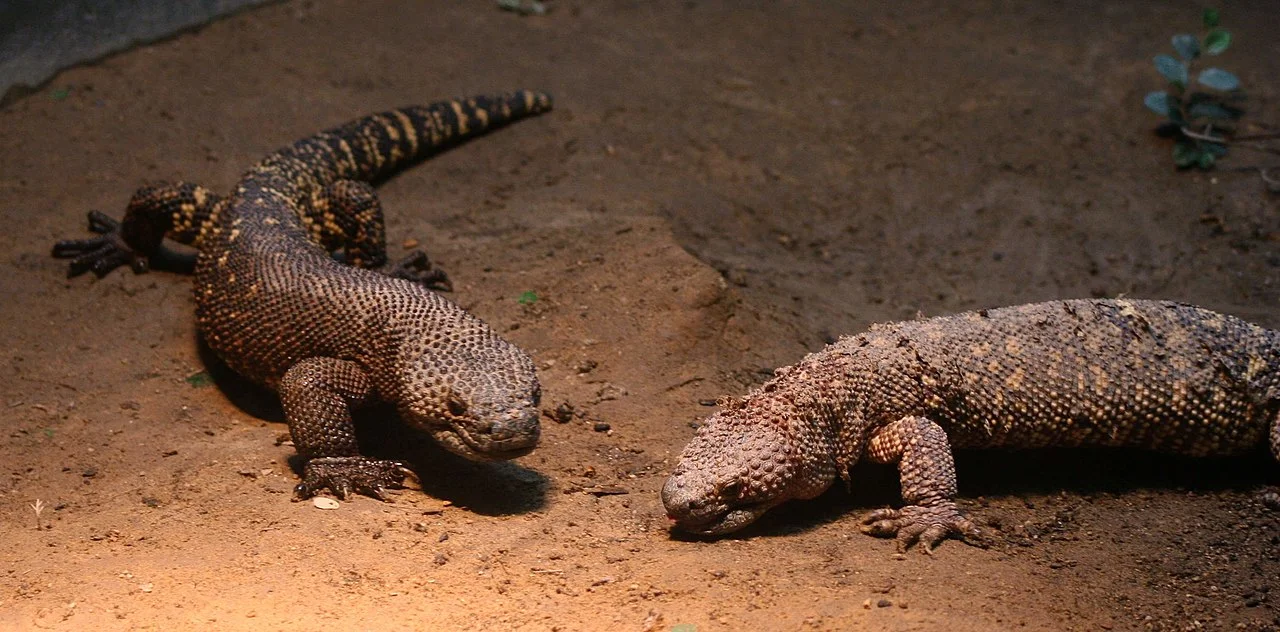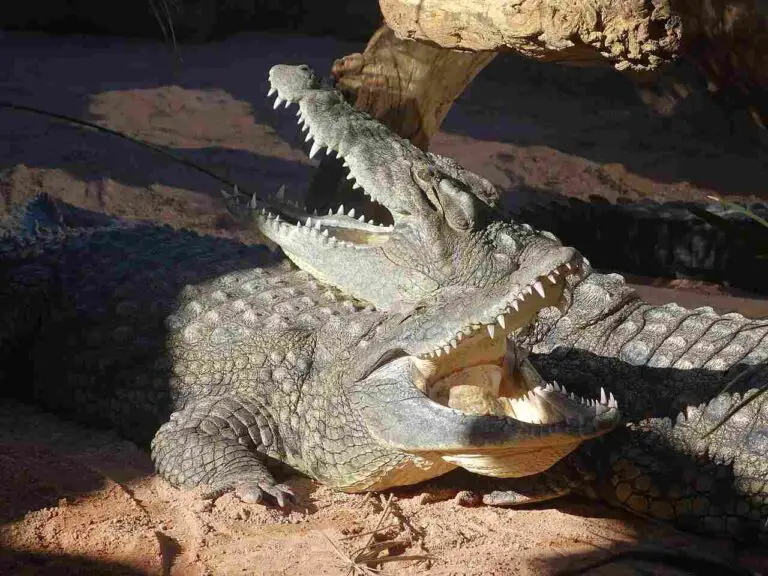Monitor Lizard Vs Iguana Size, Weight, Overall Comparison
In the intriguing realm of reptilian encounters, the clash between a monitor lizard and an iguana unfolds with distinct differences. Exploring the nuances of these creatures’ traits and capabilities provides insights into the potential outcomes of a hypothetical confrontation.
I. Varied Characteristics:
– Dark-colored iguanas can be distinguished by a spiny crest and a dewlap, while Nile monitor lizards boast smooth necks and lack a noticeable dewlap.
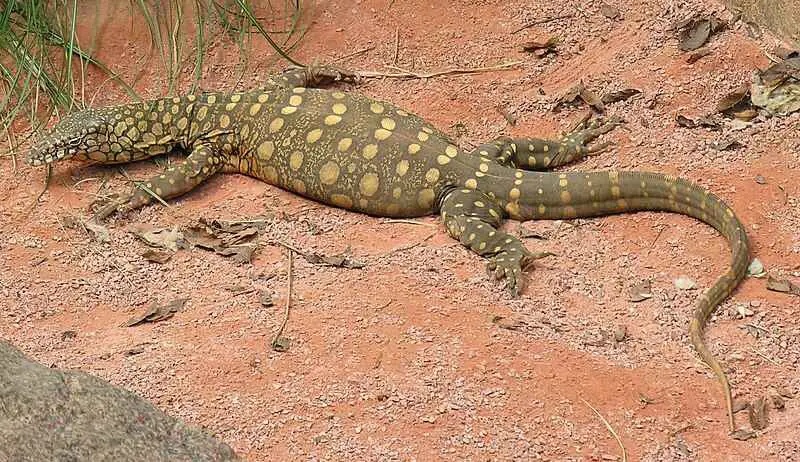
II. Geographical Distribution:
– Iguanas are predominantly found in Central and South America, whereas monitor lizards have a global presence.
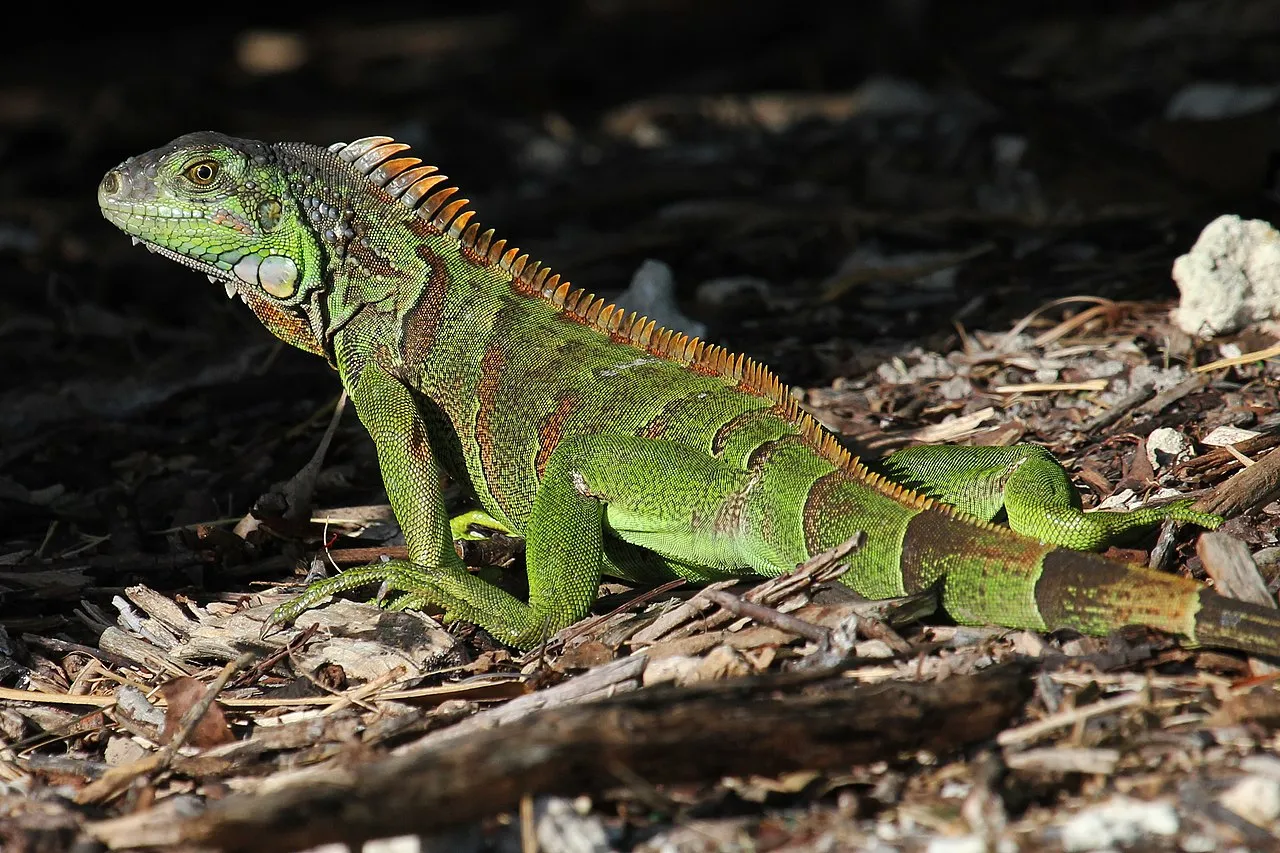
III. Dietary Distinctions:
– Iguanas are mostly herbivores, consuming plant matter, while monitor lizards are carnivores, showcasing a different dietary preference.
IV. Physical Differences:
– Water monitor lizards, a specific type, are larger with a robust body shape, smooth skin, and a shorter tail compared to spiny-tailed iguanas.
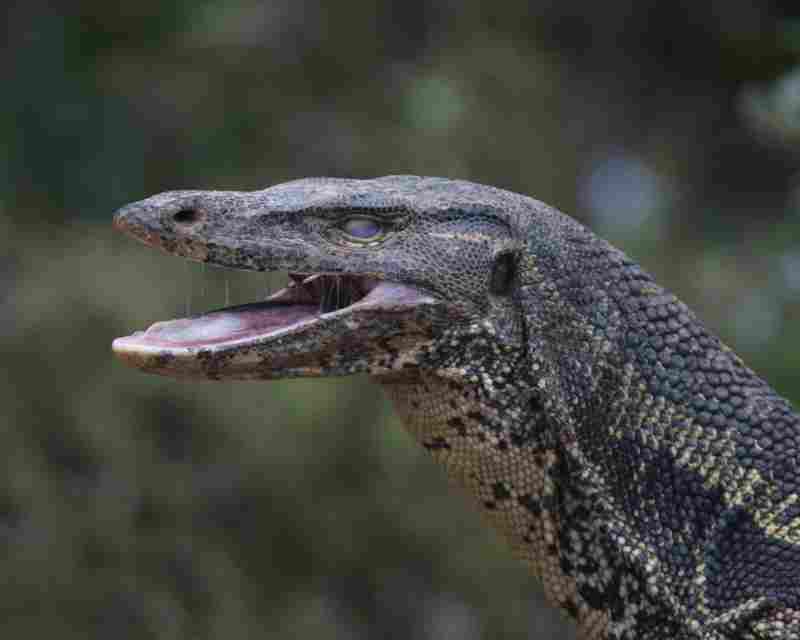
V. Encounter Speculation:
– The ultimate winner in a fight between a monitor lizard and an iguana depends on the interplay of these differences, including size, habitat, and predatory adaptations. On average, a monitor lizard would defeat an iguana using its size, weight, and venomous secretions.
*Details of Comparison
| Criteria | Monitor Lizard | Iguana |
| Taxonomy | Squamata, Varanidae, Varanus |
Squamata, Iguanidae, Iguana
|
| Appearance | Varied, elongated bodies, rough scales |
Stout bodies, smooth scales, dewlap
|
| Size | Broad range, includes large species |
Varies, green iguanas among larger species
|
| Weight | Variable, larger species notably heavy |
Ranges, with green iguanas among heavier
|
| Bite Force (PSI) | Variable, some species with high forces |
Generally lower, adapted for herbivory
|
| Offensive Advantages | Sharp claws, powerful bite, some venom |
Sharp claws, less adapted for aggression
|
| Defensive Advantages | Tough scales, defensive tail use |
Defensive tail use, ability to climb trees
|
| Speed | Varied speeds, some species reach 20 km/h |
Agile climbers, terrestrial speed ~16 km/h
|
| Agility | Agile climbers and swimmers |
Highly agile climbers, arboreal adaptation
|
| Senses | Excellent eyesight, keen smell, good hearing |
Good eyesight, strong olfactory senses
|
| Physical Capacity | Robust build, powerful limbs and tail |
Sturdy body, focus on climbing adaptations
|
| Habitat Preference | Diverse habitats globally |
Tropical regions, primarily Americas
|
| Tracks | Distinctive with claw marks and tail drag |
Tracks may show claw marks, less pronounced
|
| Lifespan | Varied, longer lifespans in larger species |
Generally shorter lifespans
|
| Feeding | Carnivorous, some venomous |
Primarily herbivorous
|
| Intelligence | Problem-solving skills |
Exhibits intelligence in adapting
|
| Social Behavior | Varied social structures |
Generally solitary
|
| Reproduction | Varied modes, some oviparous, some viviparous |
Primarily oviparous
|
| Parental Behavior | Limited parental care |
Minimal care after laying eggs
|
| Proximity to Humans | Some adapt to human-altered environments |
Green iguanas may inhabit urban areas
|
| Behavior Toward Humans | Generally wary, larger monitors can pose risks |
Generally tolerant, may become aggressive
|
| Danger to Humans | Larger monitors can pose a threat |
Generally not dangerous, but bites possible
|
| Precautions | Caution needed, education on safe interactions |
Awareness of bites and scratches, avoid provocation
|
| Conservation Status | Varied, facing threats like habitat loss |
Varied, threats include habitat destruction
|
Key Points
- Monitors generally have a more varied appearance, larger size, and broader geographic distribution compared to iguanas.
- Offensive tools differ, with monitors often having more potent capabilities, including venom.
- Reproductive strategies, parental care, and behaviors toward humans vary between the two groups.
- Both face conservation challenges, including habitat loss and exploitation for the pet trade.
1. Taxonomy
Monitor Lizard:
Order: Squamata
Family: Varanidae
Genus: Varanus
Species examples: Varanus komodoensis (Komodo dragon), Varanus niloticus (Nile monitor)
Iguana:
Order: Squamata
Family: Iguanidae
Genus: Iguana
Species examples: Iguana iguana (Green iguana), Ctenosaura similis (Black spiny-tailed iguana)
2. Appearance
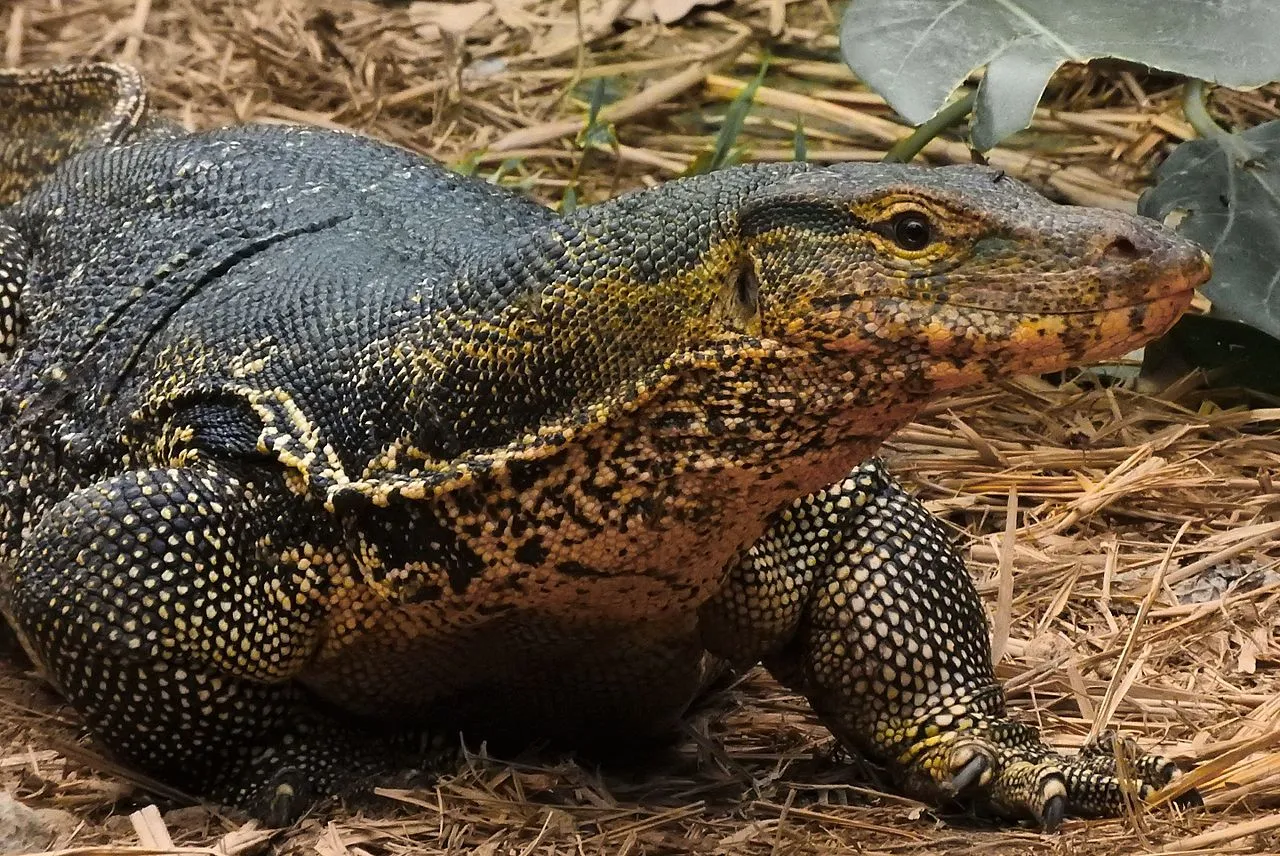
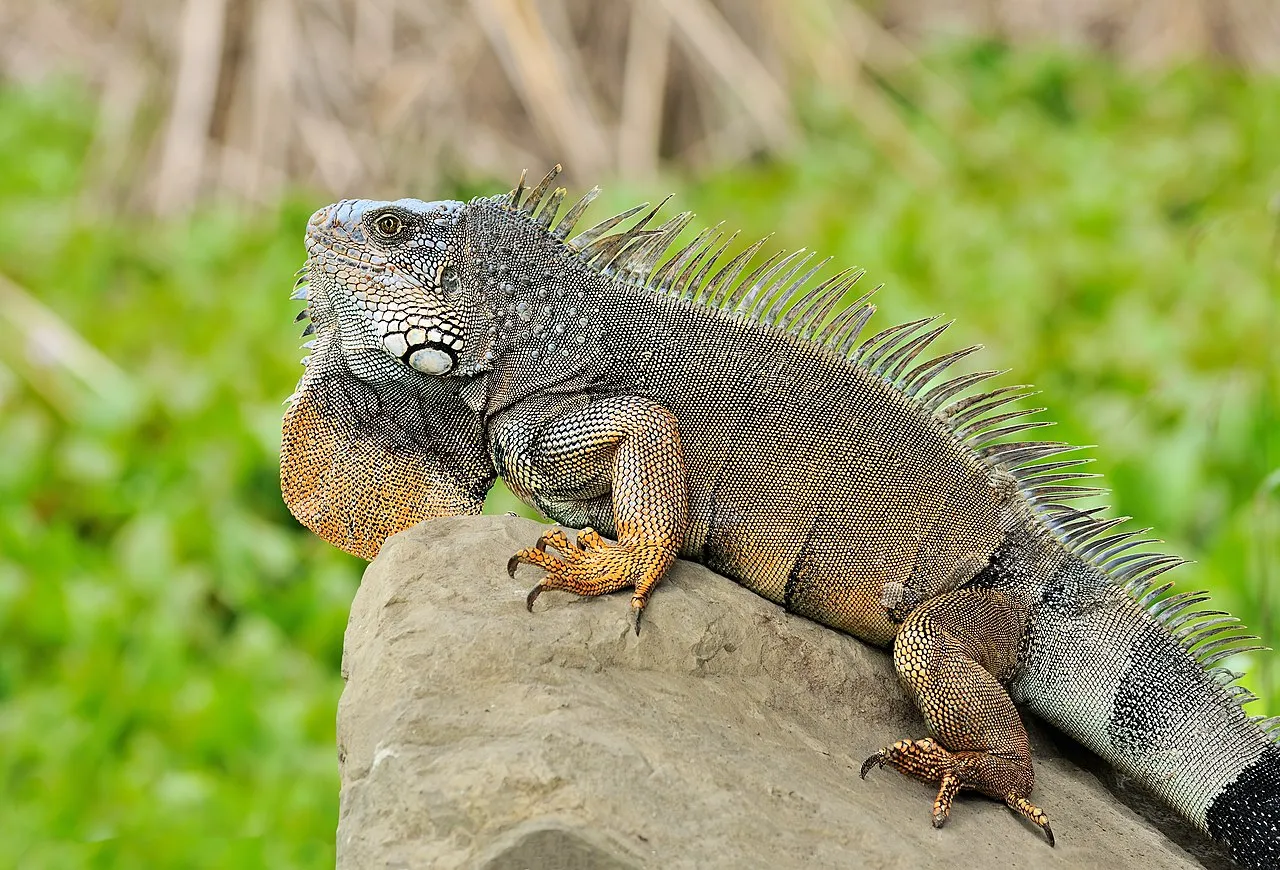
Monitor Lizard:
Varied appearances; elongated bodies, long tails, well-developed limbs, robust build.
Scales may be rough or keeled.
Some species exhibit vibrant colors.
Iguana:
Typically characterized by a stout body, long tail, and sturdy limbs.
Prominent dewlap (skin flap) beneath the throat in some species.
Scales often smooth.
Comparison:
Monitors generally have a more varied appearance, with some species showcasing vivid colors, while iguanas have a more consistent, robust look.
Ecological Implications:
Varied appearances in monitors can aid in camouflage or species-specific environmental adaptations.
The dewlap in iguanas may play a role in communication and species recognition.
3. Size
Monitor Lizard:
Sizes range widely; from smaller species like the Timor monitor (around 12 inches) to the Komodo dragon (up to 10 feet).
Iguana:
Sizes vary; green iguanas can reach lengths of 6 feet, while smaller species like the spiny-tailed iguana may measure around 2 feet.
Comparison:
Monitors generally exhibit a broader size range, including some of the largest lizard species.
Ecological Implications:
Size influences ecological roles, with larger monitors potentially occupying apex predator positions.
4. Weight
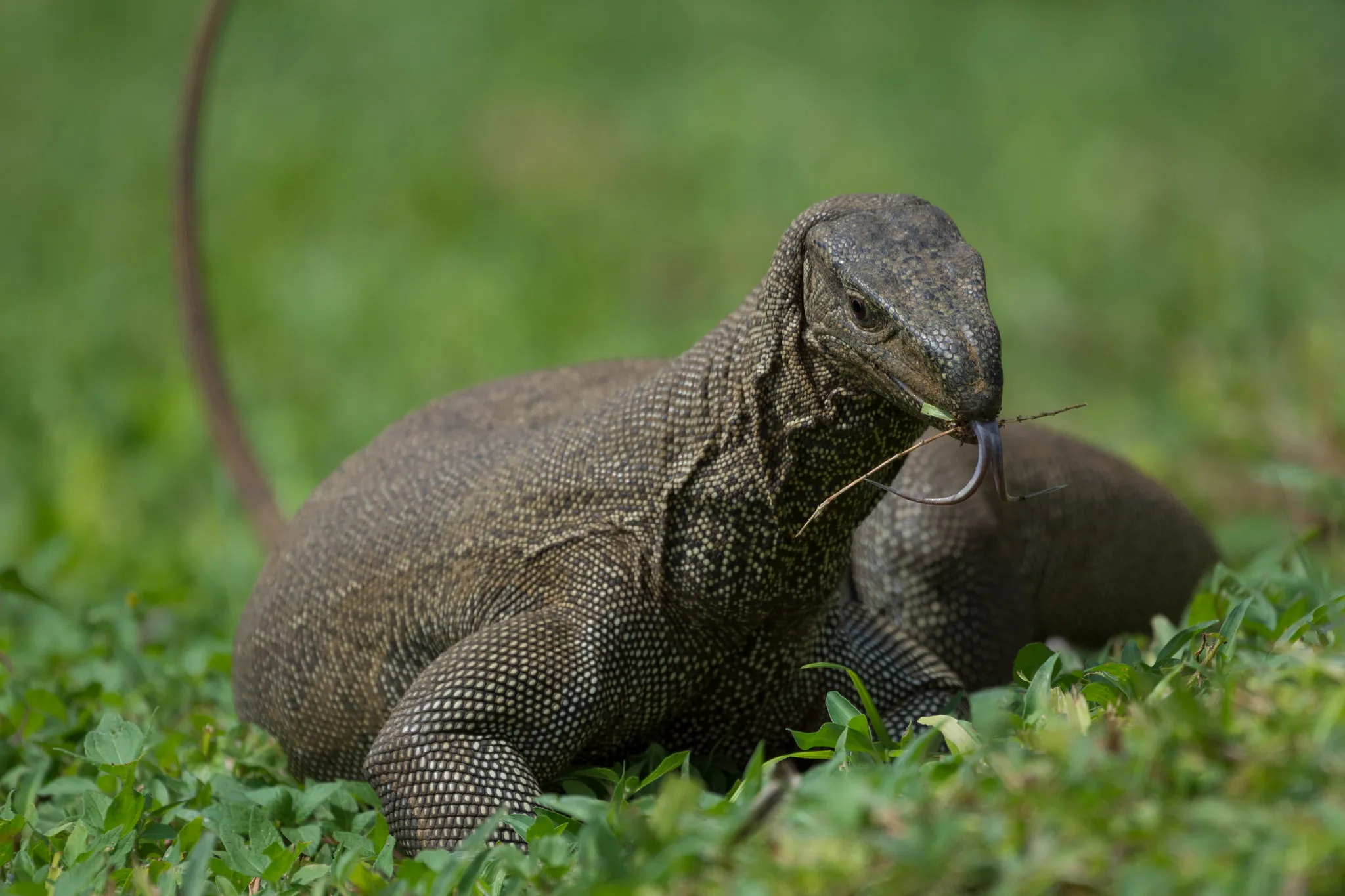
Monitor Lizard:
Weight varies significantly; Komodo dragons can weigh over 150 kg, while smaller monitors may weigh only a few hundred grams.
Iguana:
Weight ranges; green iguanas can weigh around 4.5 kg, whereas smaller species may weigh a few hundred grams.
Comparison:
Monitors generally include heavier species, particularly the large Komodo dragon.
Ecological Implications:
Weight affects ecological interactions, with larger monitors potentially influencing prey populations more significantly.
5. Bite Force (PSI)
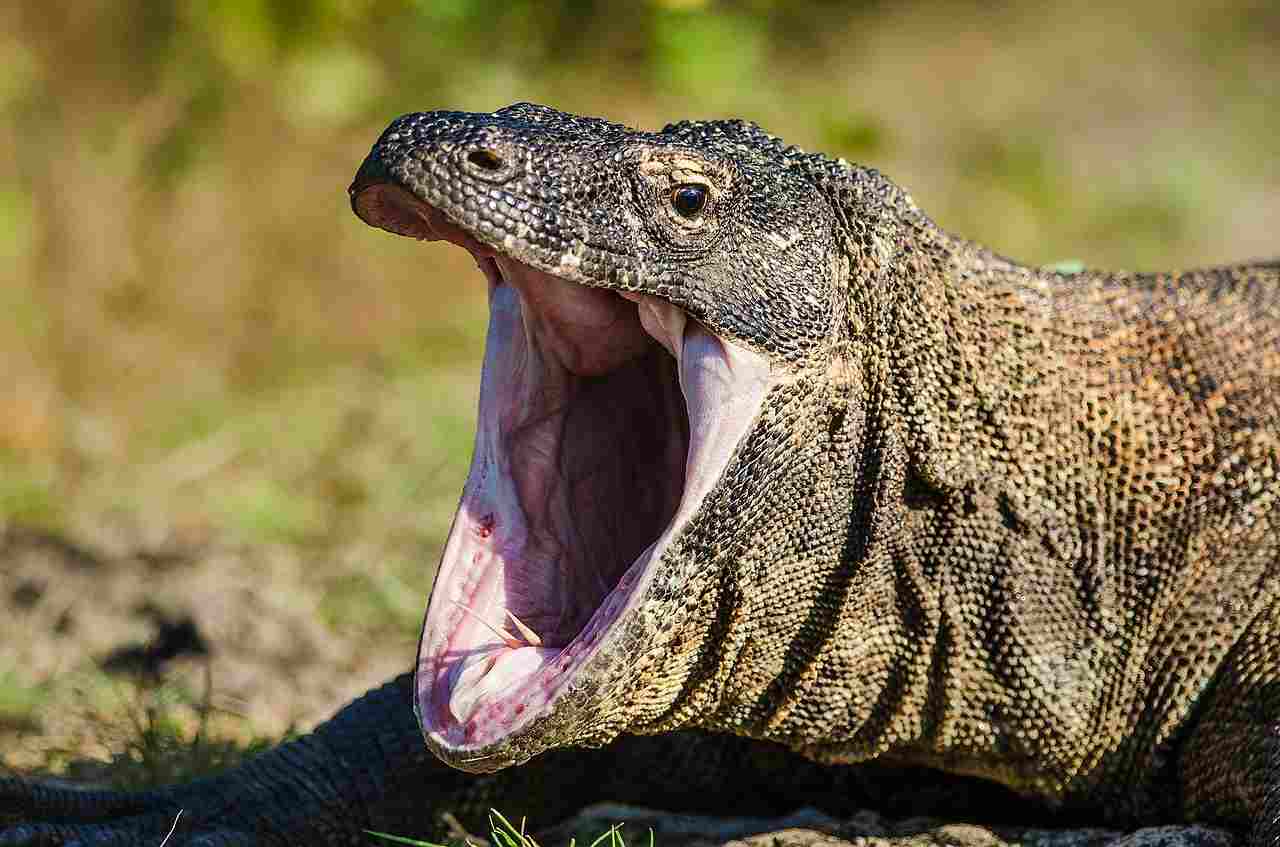
Monitor Lizard:
Variable; Komodo dragons have a powerful bite, with estimations ranging up to 700 PSI.
Iguana:
Bite force is less compared to monitors, typically adapted for herbivorous diets.
Comparison:
Monitors, especially the Komodo dragon, possess a higher bite force.
Ecological Implications:
Strong bite forces in monitors are adapted for hunting and subduing prey, influencing their position in the food chain.
6. Physical Offensive Advantages
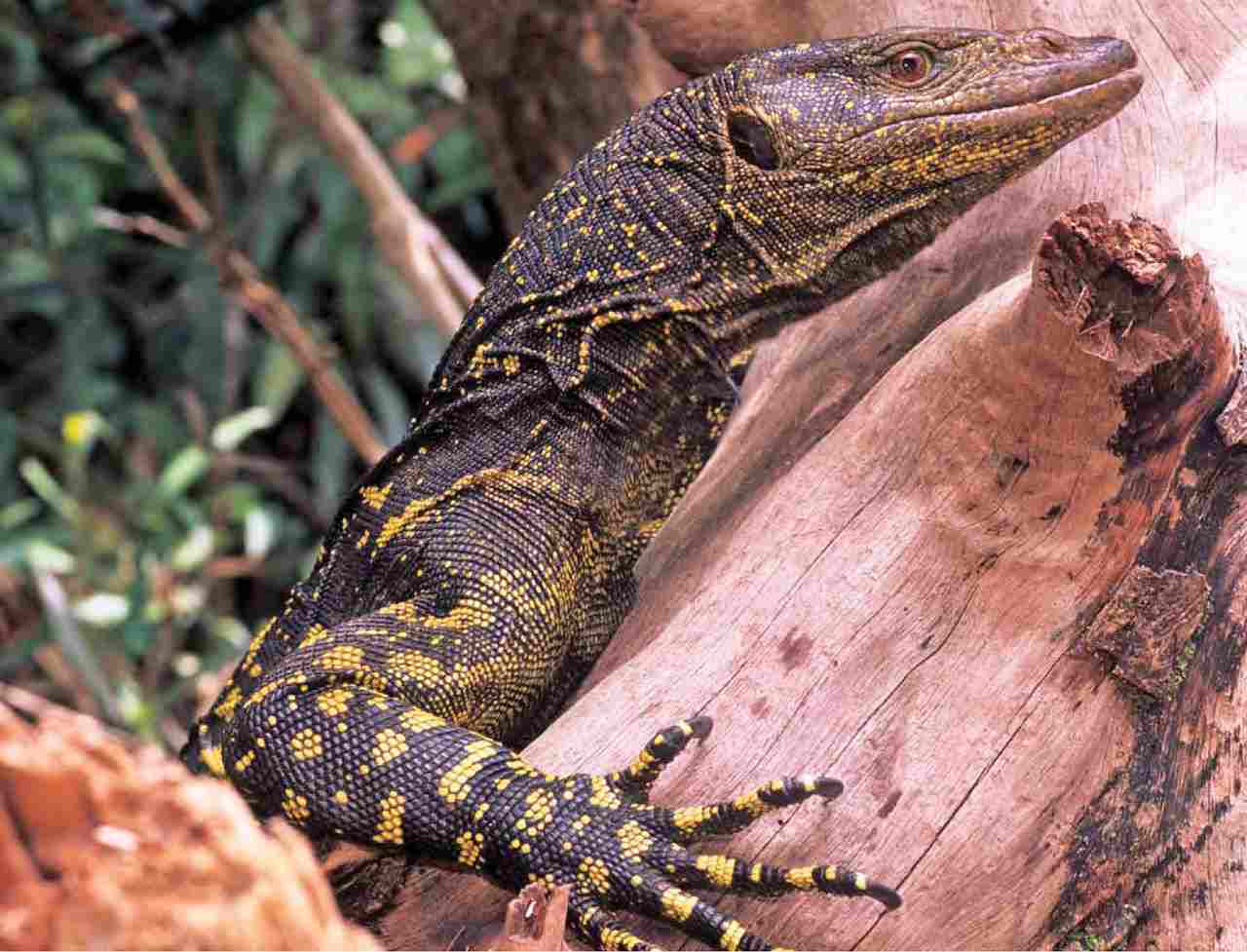
Monitor Lizard:
Sharp claws and teeth, powerful bite force.
Some species possess venom, notably the Komodo dragon.
Iguana:
Sharp claws and teeth, but generally less adapted for aggressive encounters.
Comparison:
Monitors, especially with venom, have more potent offensive tools.
Ecological Implications:
These adaptations aid monitors in hunting and defense, influencing their ecological role.
7. Physical Defensive Advantages
Monitor Lizard:
Tough scales provide protection.
Tail can be used as a defensive tool.
Iguana:
Tail can be used for defense.
Ability to climb trees to escape predators.
Comparison:
Both have defensive mechanisms, with monitors relying more on scale toughness.
Ecological Implications:
Defensive strategies influence their survival against predators, shaping their role in ecosystems.
8. Speed (Km/hour or Mile/hour)
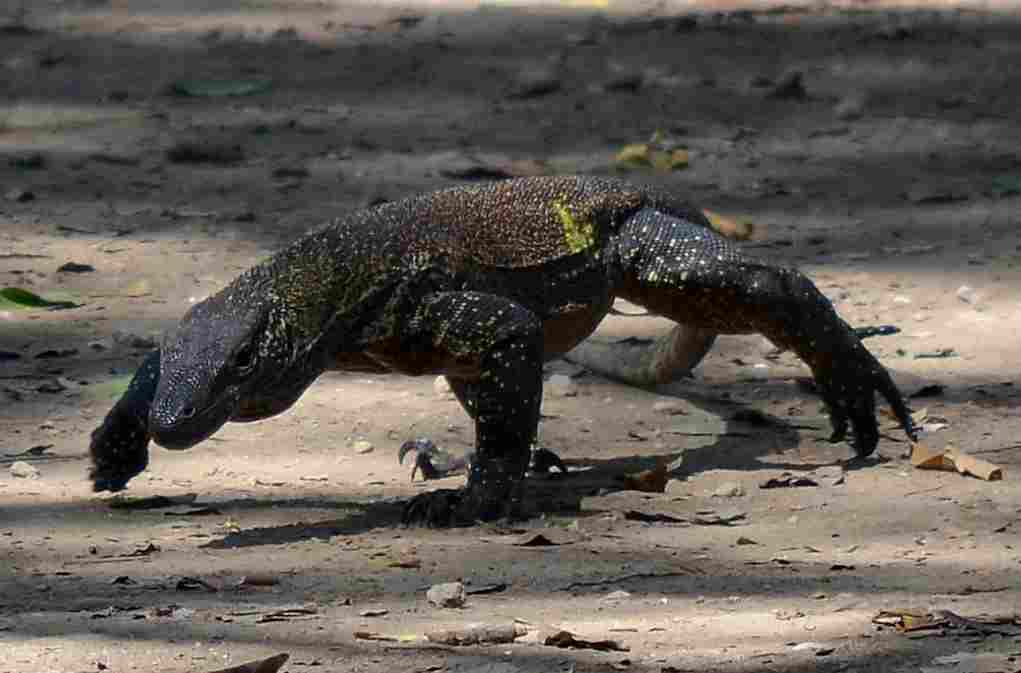
Monitor Lizard:
Varied speeds; Komodo dragons can run at speeds up to 20 km/h (12 mph).
Iguana:
Agile climbers but terrestrial speed is generally lower; around 16 km/h (10 mph).
Comparison:
Komodo dragons show comparable or slightly higher speeds.
Ecological Implications:
Speed influences their hunting strategies and ability to escape predators.
9. Agility
Monitor Lizard:
Agile climbers and swimmers, demonstrating flexibility.
Iguana:
Highly agile climbers, well-adapted to arboreal environments.
Comparison:
Iguanas often exhibit superior agility in climbing.
Ecological Implications:
Agility is crucial for navigating diverse habitats, impacting their ecological niche.
10. Senses
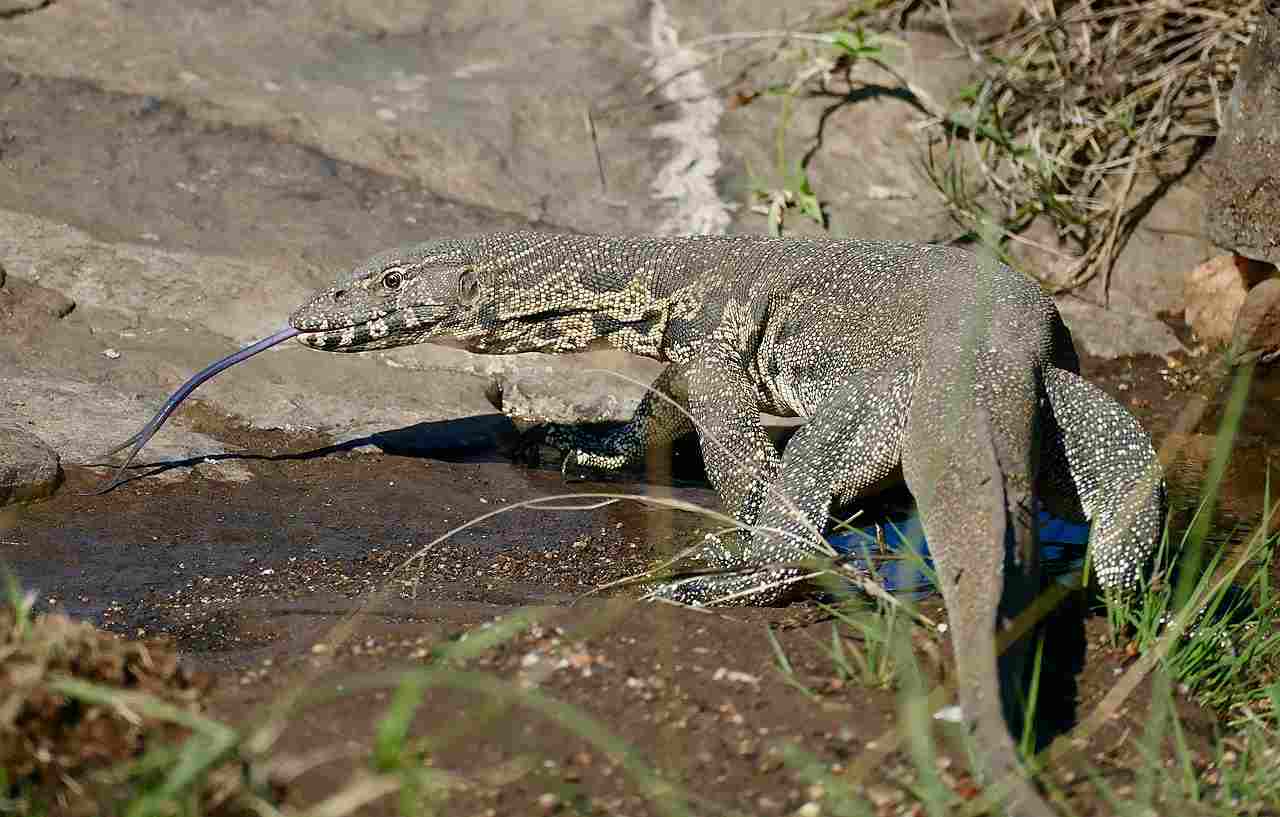
Monitor Lizard:
Excellent eyesight, keen sense of smell, and well-developed hearing.
Iguana:
Good eyesight, especially for detecting movement.
Well-developed olfactory senses.
Comparison:
Both possess heightened senses, with monitors having an edge in hearing.
Ecological Implications:
Enhanced senses aid in detecting prey, predators, and navigating their environment.
11. Overall Physical Capacity
Monitor Lizard:
Robust build, powerful limbs, and tail.
Iguana:
Sturdy body with a focus on climbing adaptations.
Comparison:
Monitors generally have a more versatile physical capacity.
Ecological Implications:
Physical capacity determines their ability to fulfill ecological roles and adapt to diverse habitats.
12. Habitat Preference(s) and Geographic Region
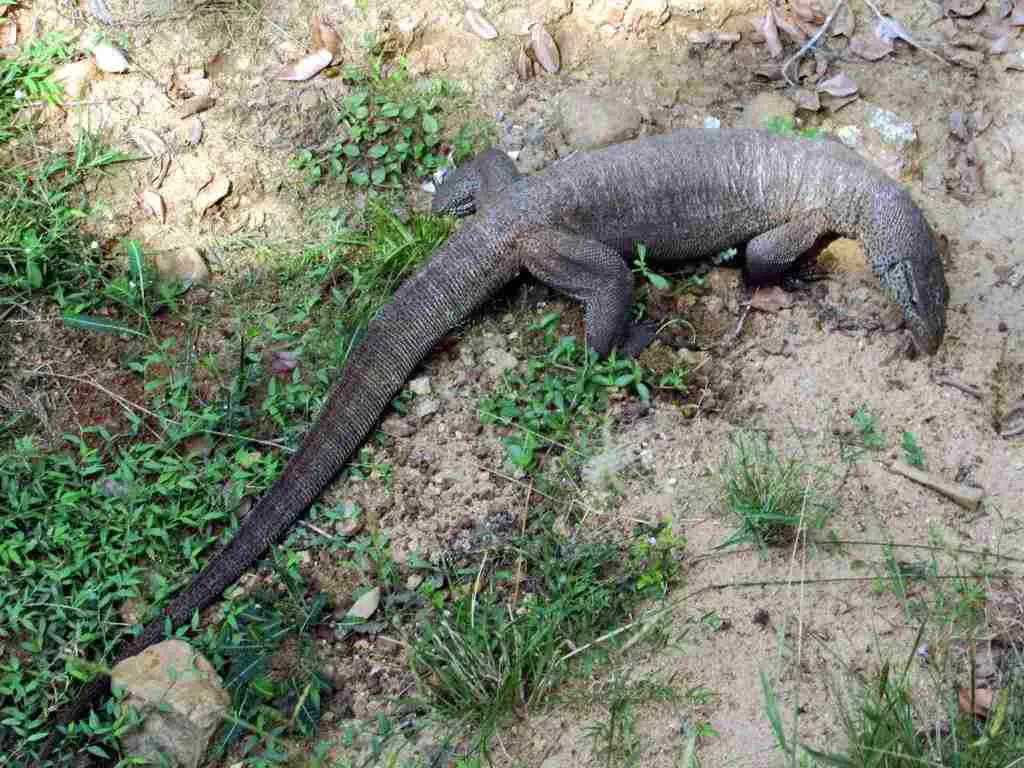

Monitor Lizard:
Diverse habitats including forests, grasslands, and deserts.
Geographically distributed across Africa, Asia, Australia, and some Pacific islands.
Iguana:
Arboreal and terrestrial habitats in tropical regions.
Predominantly found in Central and South America.
Comparison:
Monitors exhibit a broader geographic distribution and habitat range.
Ecological Implications:
Habitat preferences influence their interactions with other species and the ecosystems they inhabit.
13. Tracks
Monitor Lizard:
Distinctive tracks with claw marks and a powerful tail drag.
Iguana:
Tracks may show claw marks and tail drags, but less pronounced than monitors.
Comparison:
Monitors leave more distinctive tracks due to their robust build.
Ecological Implications:
Track identification aids researchers in monitoring populations and understanding their movements.
14. Lifespan
Monitor Lizard:
Lifespan varies; smaller species may live around 5-10 years, while larger species like the Komodo dragon can exceed 30 years.
Iguana:
Generally, lifespans range from 10 to 20 years.
Comparison:
Monitors, especially large species, tend to have longer lifespans.
Ecological Implications:
Lifespan influences reproductive strategies and population dynamics.
15. Mode of Feeding
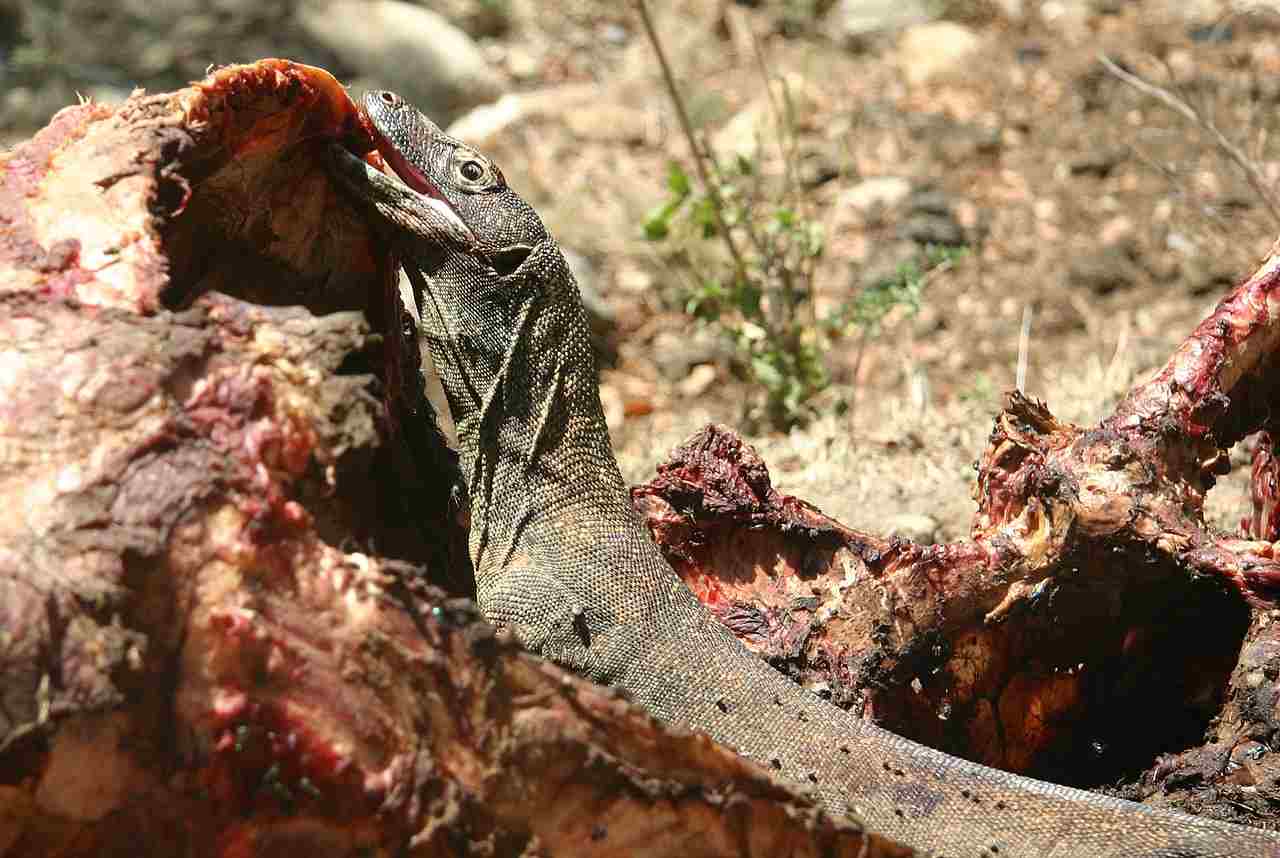
Monitor Lizard:
Carnivorous diet; hunts and scavenges.
Some species, like the Komodo dragon, use venom to subdue prey.
Iguana:
Primarily herbivorous; feeding on leaves, fruits, and flowers.
Some species may consume insects.
Comparison:
Monitors are predominantly carnivorous, while iguanas are herbivorous.
Ecological Implications:
Feeding habits contribute to their role in nutrient cycling and energy flow within ecosystems.
16. Intelligence
Monitor Lizard:
Demonstrates problem-solving skills; capable of learning.
Iguana:
Exhibits intelligence, especially in adapting to changing environments.
Comparison:
Both show cognitive abilities, with monitors often considered more intelligent.
Ecological Implications:
Intelligence influences their ability to adapt to environmental changes.
17. Social Behavior
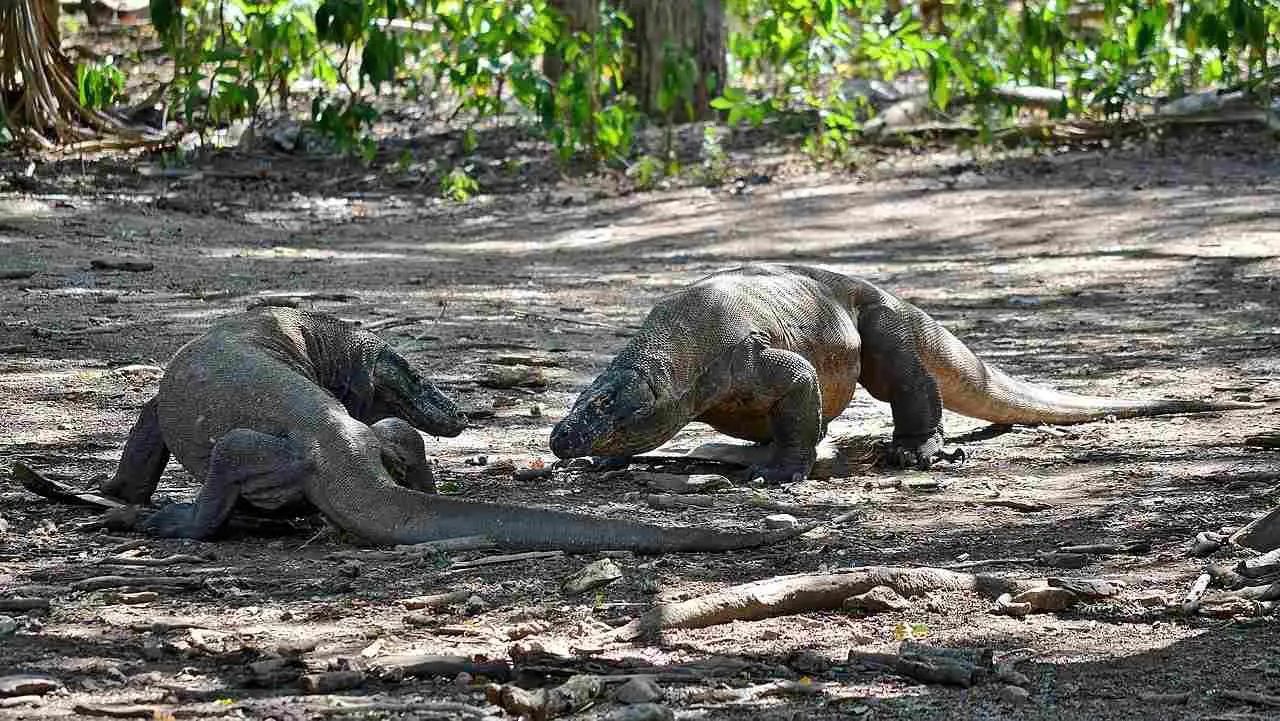
Monitor Lizard:
Varied social structures; some species are solitary, while others may form loose colonies.
Iguana:
Generally solitary, but may tolerate conspecifics in overlapping territories.
Comparison:
Monitors exhibit more diverse social behaviors.
Ecological Implications:
Social behavior affects population dynamics, resource utilization, and breeding strategies.
18. Mode of Reproduction
Monitor Lizard:
Varied reproductive strategies; some lay eggs (oviparous), while others give birth to live young (viviparous).
Nesting habits vary among species.
Iguana:
Primarily oviparous; females lay eggs in nests.
Comparison:
Monitors display a wider range of reproductive modes.
Ecological Implications:
Reproductive strategies influence population dynamics and species interactions.
19. Parental Behavior

Monitor Lizard:
Limited parental care; some species guard nests, but offspring are largely independent.
Iguana:
Minimal parental care after laying eggs; offspring are left to fend for themselves.
Comparison:
Both exhibit limited parental care, with slight variations.
Ecological Implications:
Parental behavior influences juvenile survival rates and population dynamics.
20. Proximity to Human-Inhabited Areas
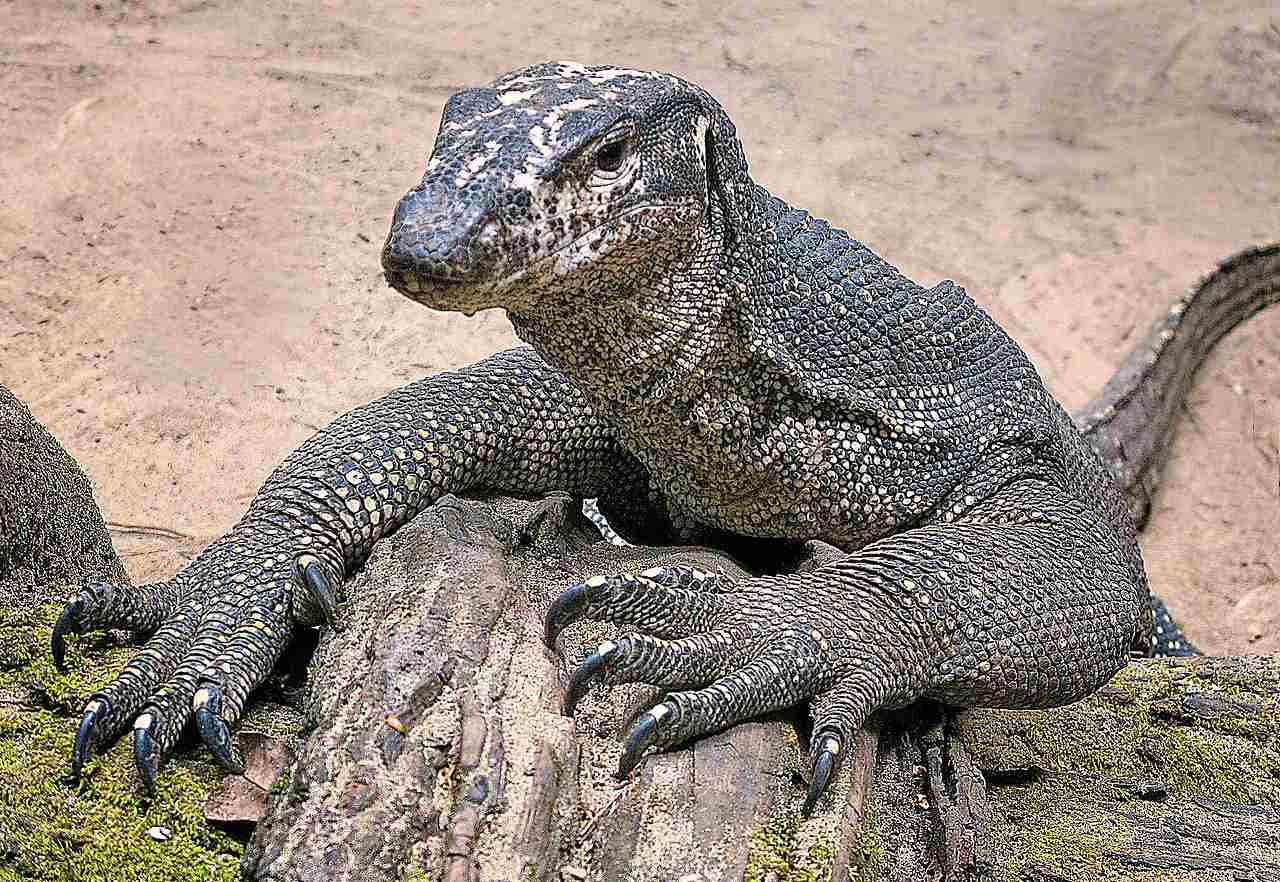
Monitor Lizard:
Some species adapt to human-altered environments, leading to proximity in urban areas.
Iguana:
Green iguanas are known to inhabit urban areas in some regions.
Comparison:
Both may coexist with humans, adapting to anthropogenic landscapes.
Ecological Implications:
Proximity to human areas raises concerns about potential conflicts and impacts on local ecosystems.
21. Behavior Toward Humans
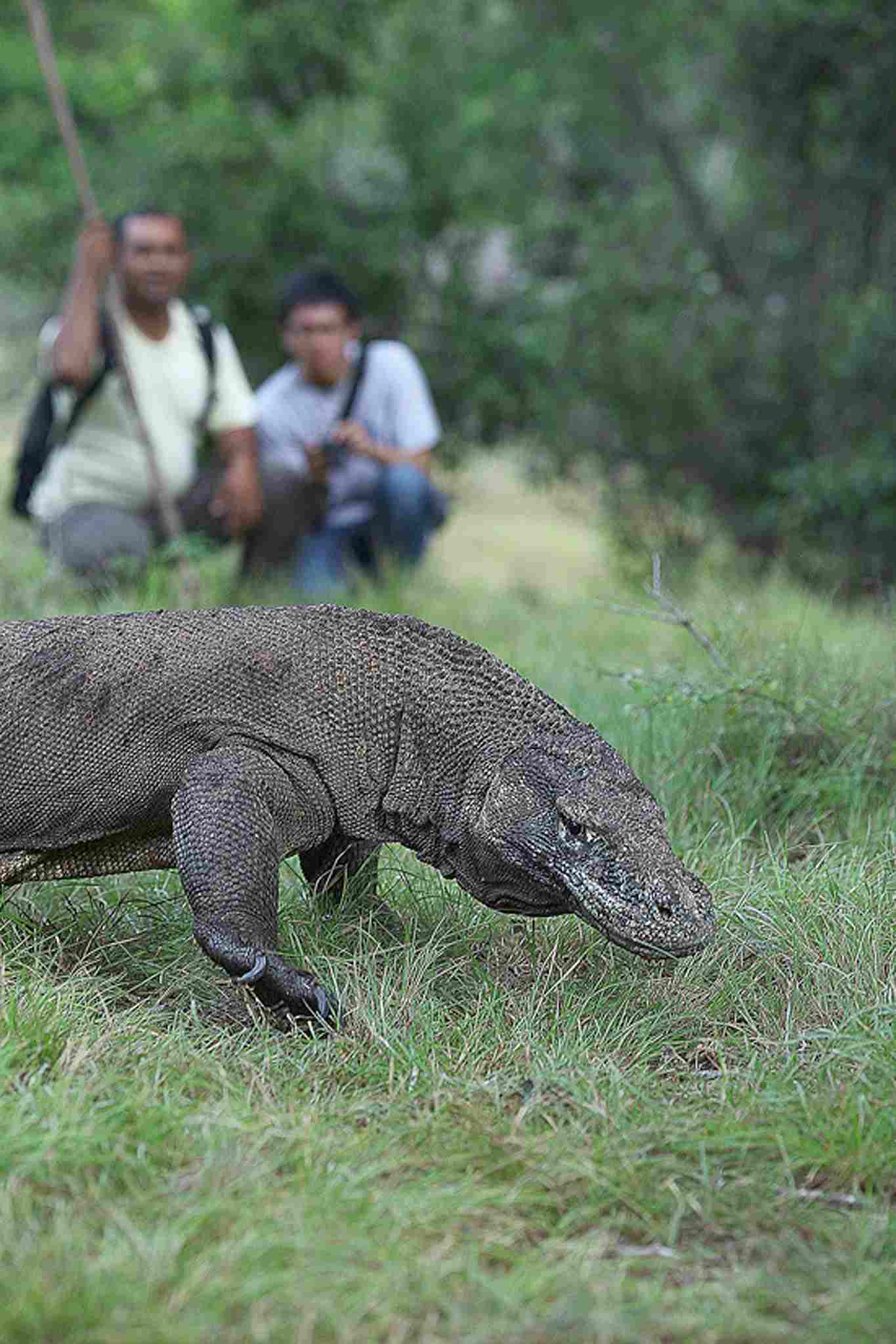

Monitor Lizard:
Generally wary of humans, but some may become accustomed to human presence.
Larger monitors can pose risks if they feel threatened.
Iguana:
Green iguanas may show tolerance but can become aggressive if cornered.
Comparison:
Both may exhibit defensive behaviors, with larger monitors potentially posing greater risks.
Ecological Implications:
Human interactions can affect their behavior, influencing their survival in human-altered environments.
22. Danger Posed to Humans
Monitor Lizard:
Larger monitors, especially the Komodo dragon, can pose a threat if provoked.
Generally, monitors are more capable of causing harm compared to smaller species.
Iguana:
Green iguanas are not typically dangerous but can deliver bites and scratches if provoked.
Comparison:
Larger monitors, due to their size and capabilities, can pose a greater danger.
Ecological Implications:
Human safety concerns influence conservation efforts and management strategies.
23. Associated Precautions
Monitor Lizard:
Caution required when in regions with large monitors; avoid provoking or approaching them.
Conservation efforts should include education on safe interactions.
Iguana:
Awareness of potential bites or scratches; avoid cornering or startling them.
Conservation measures often involve habitat preservation.
Comparison:
Similar precautions for both, with an emphasis on size-related risks for monitors.
Ecological Implications:
Human behavior influences the coexistence and conservation of these species.
24. Conservation Status
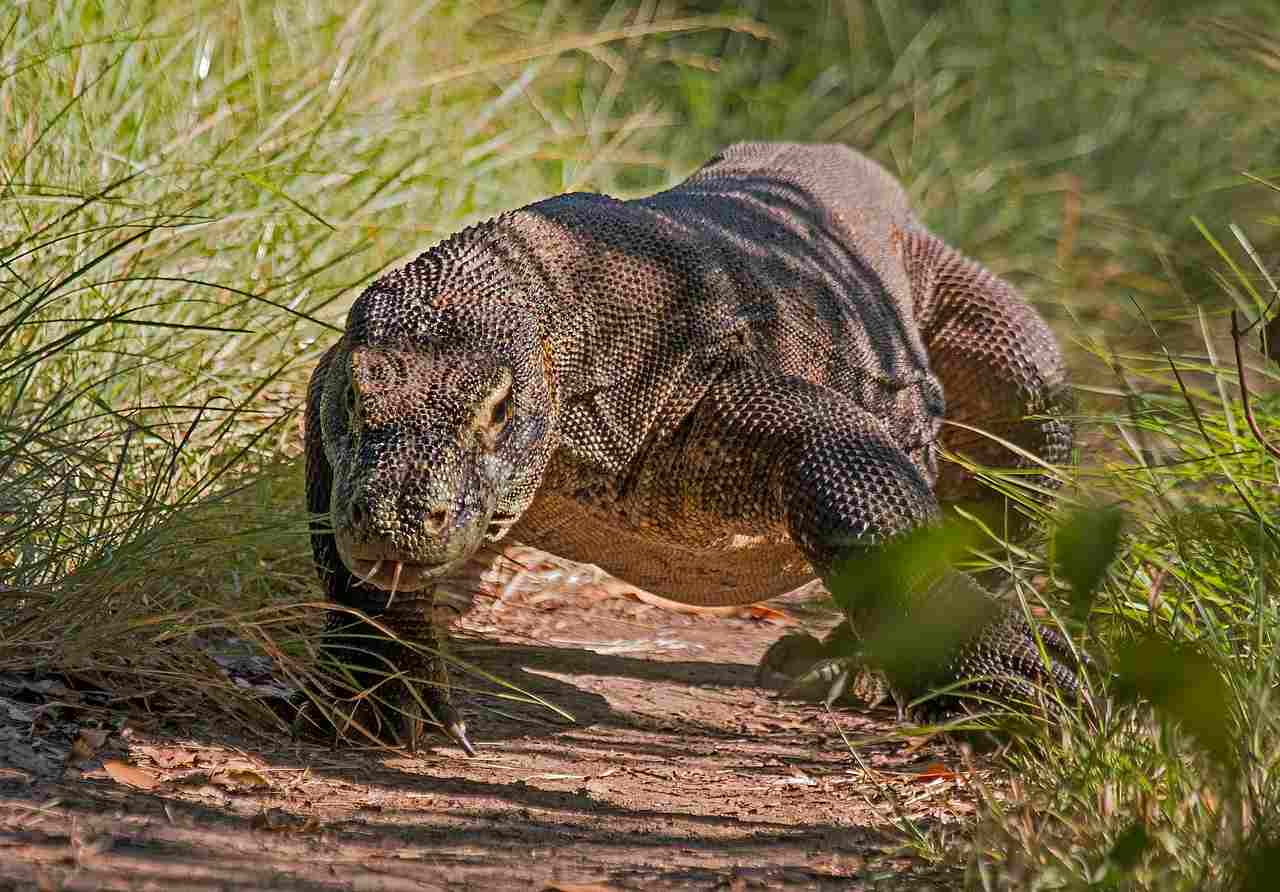
Monitor Lizard:
Varied conservation statuses; some species are endangered due to habitat loss and poaching, while others are more stable.
Iguana:
Conservation status varies; some species are threatened by habitat destruction and the pet trade.
Comparison:
Both groups include species of conservation concern.
Ecological Implications:
Conservation efforts are crucial to maintaining biodiversity and ecosystem health.
*Summary of Comparison
Taxonomy:
Monitors: Order – Squamata, Family – Varanidae, Genus – Varanus.
Iguanas: Order – Squamata, Family – Iguanidae, Genus – Iguana.
Appearance:
Monitors: Varied, elongated bodies, rough or keeled scales, some vibrant colors.
Iguanas: Generally stout bodies, smooth scales, prominent dewlap in some species.
Size:
Monitors: Broad size range, from small to large species (e.g., Komodo dragon).
Iguanas: Sizes vary, with green iguanas among the larger species.
Weight:
Monitors: Variable weights, with larger species like Komodo dragons being notably heavy.
Iguanas: Weight ranges, with green iguanas being among the heavier species.
Bite Force (PSI):
Monitors: Varied, with some species like Komodo dragons having high bite forces.
Iguanas: Generally lower bite forces adapted for herbivorous diets.
Physical Offensive Advantages:
Monitors: Sharp claws, powerful bite, some species with venom.
Iguanas: Sharp claws and teeth, less adapted for aggressive encounters.
Physical Defensive Advantages:
Monitors: Tough scales, defensive tail use.
Iguanas: Defensive tail use, ability to climb trees.
Speed:
Monitors: Varied speeds, with Komodo dragons reaching up to 20 km/h.
Iguanas: Agile climbers, terrestrial speed around 16 km/h.
Agility:
Monitors: Agile climbers and swimmers.
Iguanas: Highly agile climbers, well-adapted to arboreal environments.
Senses:
Monitors: Excellent eyesight, keen sense of smell, well-developed hearing.
Iguanas: Good eyesight, strong olfactory senses.
Overall Physical Capacity:
Monitors: Robust build, powerful limbs, and tail.
Iguanas: Sturdy body with a focus on climbing adaptations.
Habitat Preference(s) and Geographic Region:
Monitors: Diverse habitats globally.
Iguanas: Tropical regions, primarily Central and South America.
Tracks:
Monitors: Distinctive tracks with claw marks and tail drag.
Iguanas: Tracks may show claw marks and tail drags.
Lifespan:
Monitors: Varied, longer lifespans in larger species.
Iguanas: Generally shorter lifespans.
Mode of Feeding:
Monitors: Carnivorous, some using venom.
Iguanas: Primarily herbivorous.
Intelligence:
Monitors: Demonstrates problem-solving skills.
Iguanas: Exhibits intelligence in adapting to changing environments.
Social Behavior:
Monitors: Varied social structures.
Iguanas: Generally solitary.
Mode of Reproduction:
Monitors: Varied, some oviparous, some viviparous.
Iguanas: Primarily oviparous.
Parental Behavior:
Monitors: Limited parental care.
Iguanas: Minimal parental care after laying eggs.
Proximity to Human-Inhabited Areas:
Monitors: Some adapt to human-altered environments.
Iguanas: Green iguanas may inhabit urban areas.
Behavior Toward Humans:
Monitors: Generally wary, larger monitors can pose risks if threatened.
Iguanas: Generally tolerant but may become aggressive if provoked.
Danger Posed to Humans:
Monitors: Larger monitors can pose a threat.
Iguanas: Generally not dangerous but can deliver bites and scratches.
Associated Precautions:
Similar precautions for both, with an emphasis on size-related risks for monitors.
Conservation Status:
Both groups include species of conservation concern, facing threats like habitat loss and exploitation.
Conclusion
I) Similarities:
Both monitor lizards and iguanas are members of the Squamata order, displaying reptilian characteristics and adaptations.
Face conservation challenges due to habitat loss, human-wildlife conflict, and, in some cases, exploitation for the pet trade.
II) Differences:
Monitors tend to have a more varied appearance, larger size, and a broader geographic distribution compared to iguanas.
Monitors often exhibit more potent offensive tools, including venom, while iguanas rely more on herbivorous adaptations.
Reproductive strategies, parental care, and behaviors towards humans vary between the two groups.
